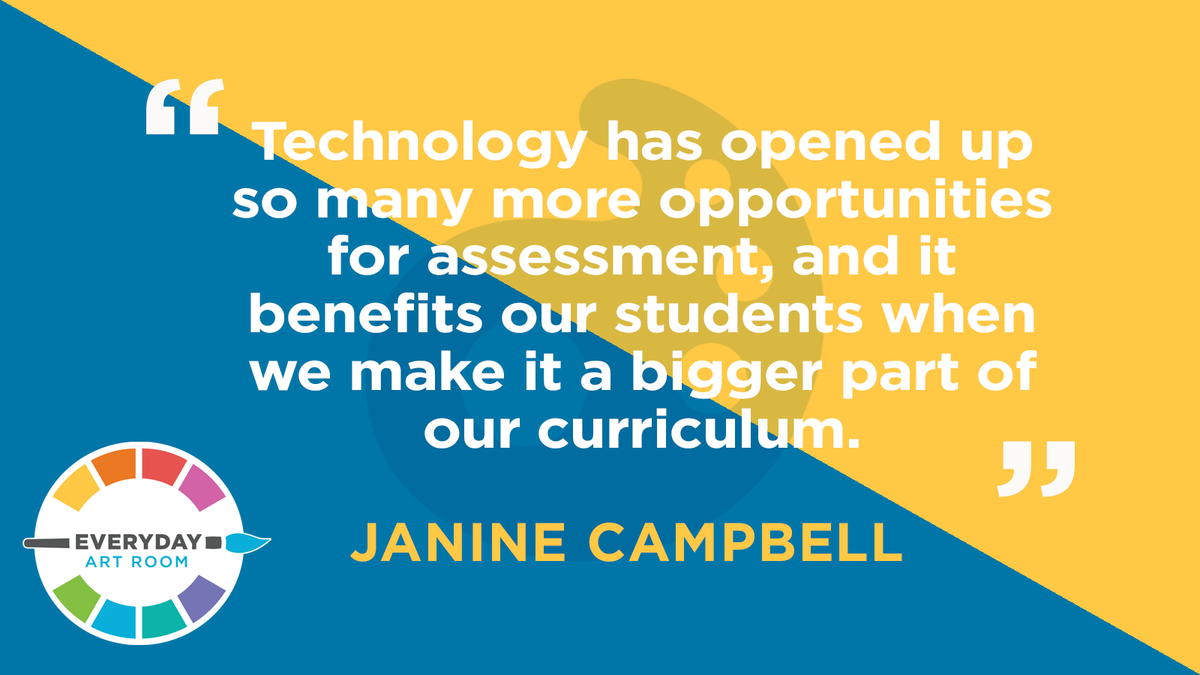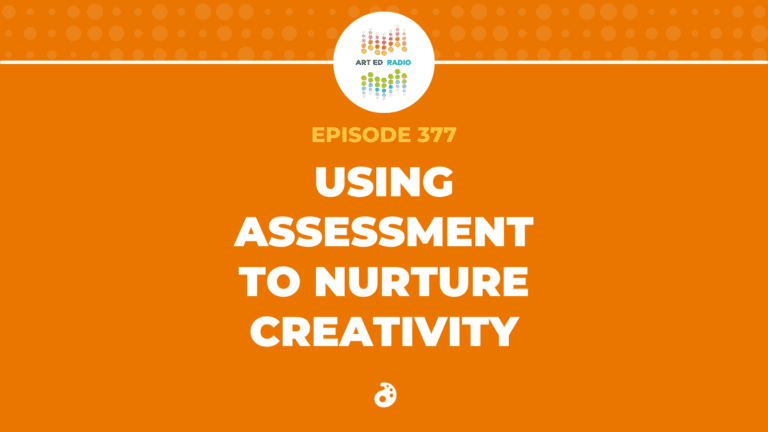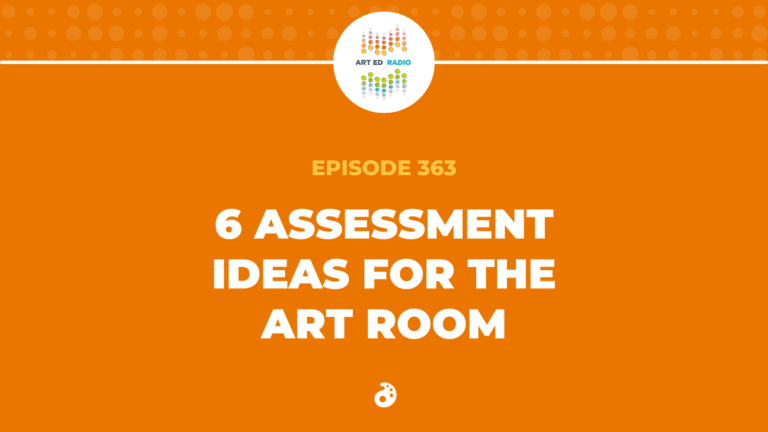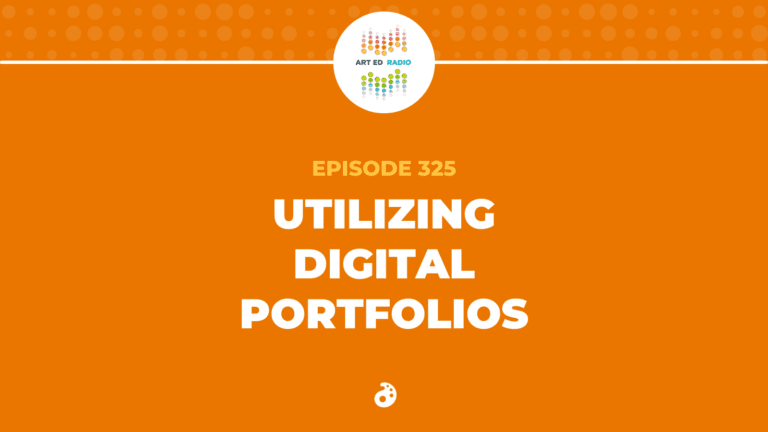Assessment can be intimidating for art teachers, especially if you don’t have a lot of experience with the topic. Today, Nic brings on Janine Campbell to share some of her best ideas to make assessment a little bit less intimidating. Listen as they discuss ways to incorporate technology with your assessment, finding time inside of a limited schedule, and how teachers can better inform themselves when it comes to assessment.
Full Episode Transcript Below.
Resources and Links
- Follow Janine on Instagram
- Janine’s blog can be found here
- Learn more about MAEIA
- Take a look at Assessment on the AOEU website

Transcript
Nic: Assessment can be a scary thing for art educators. In fact, the Art of Education University knows this. If you go to their website and type in … actually you don’t even have to type it in, it is a pull-down. You can pull down to assessments and you’re going to find such a plethora of information about assessments. We have articles. We have podcasts about this topic. We have courses and pro packs. There is just so much information and the reason being it is something that our educators are seeking as well as administrators. They want this to happen in our classroom as well.
Today we’re going to talk to Janine Campbell who has some very interesting thoughts on assessment. She’s going to share kind of the things that she’s been working on for the past several years. She is also presenting at NAEA this year for 2020 in March in my home state of Minnesota. She decided that she would take the time to chat with us about what she’s doing with assessment and how she’s making it less scary in her classroom. This is Nic Hahn and this is Everyday Art Room.
Thank you so much for joining us tonight. We are excited to have you. Will you please just give us a little bit of a background, who you are, where you’re from, what you teach?
Janine: Yeah, so I’m Janine Campbell. I’m originally from Flint, Michigan. I teach middle school visual arts over on the west side of the state at Byron Center West Middle School, which is just South of Grand Rapids. I’ve been over on the west side of the state now for 13 years. This is my 16th year of teaching visual arts.
Nic: Excellent. All right. And we’ve connected several times throughout the years. I’d say that we have a longevity between us via social media and meeting each other at our NAEA, the national conferences, so we do have some connection. I’ve always found what you have to share with our PLN or Professional Learning Network just to be very insightful and thoughtful. I’m very excited to have you in because you’re going to be chatting with us about assessment. Is assessment a passion for you? Or how did you come to like be concentrating on this currently?
Janine: Well, I would say that the turn towards assessment for me in my classroom really happened almost 10 years ago, really when we started going one-to-one with computers in my school. With the access to technology, being able to assess students using various online tools was just … it became more conducive to my classroom, and so that opened up a new door of opportunities. Then also around 2011 the Michigan Department of Education as well as the Michigan Assessment Consortium started to create a project called the MAEIA Project. MAEIA stands for Michigan Arts Education Instruction and Assessment Program.
I happened to be presenting at a conference about technology integration and one of their main leaders in the group, Kathy Dusenberry-White approached me and said, “We would really be interested with you contributing to this project because we see what you’re doing with technology and assessment and we think that you could be an interesting voice to have this part of it.” And so I’ve been involved with MAEIA since about 2011.
Nic: Yeah, Kathy definitely has an eye for talent as well. I’m glad that she brought you on. What has your role been with this programming?
Janine: The MAEIA project started out with really asking all arts teachers, not just visual arts teacher, but also theater and music teachers to look at what is the gold standard for arts education in the state of Michigan. Our project went through and looked at what would be the classroom resources you needed, budgets, certification offerings in terms of minutes per week, what would be the gold standard for visual arts education, K through 12th grade in the state of Michigan?
Then from there we created a blueprint of what we thought was that standard. With that blueprint we also created an audit tool and that audit tool would then go into schools and look and see where is your programming in terms of standards, like are you doing the offerings? Are you providing the resources, the facilities, the certification of teachers that is necessary to really give the students of Michigan a gold standard arts education?
Nic: And that, excuse me for interrupting, that isn’t really necessarily a comment on the art educator, but like maybe what’s being provided throughout the school district, would you say?
Janine: Yes, it’s more of a commentary on what’s happening within the district because a lot of times, and I know this from even my personal experience, you only have so much time with your students. And so if, for example, in my case, when students come from the middle school, they have to make a choice between art and music. They really, unless they do some things outside of the school day, they don’t have room in their schedule to do both.
So if I don’t see a student, let’s say their seventh grade year, when I see them in eighth grade, that’s a gap in education. I know that there are some districts out there where they don’t offer art to elementary students or there may be a gap in the education. When it comes time for teachers to be evaluated, which is really one of the driving focuses of this, is how are we evaluated as teachers?
Well, if teachers are evaluated based on student growth and what students know and are able to do, if there are gaps in these education, then how are we able to accurately evaluate the teacher and what they’re able to do?
Nic: Right on.
Janine: One of the remedies to that and one of the tools that we’re hoping to, as a group of teachers as well as these professionals from the assessment consortium, was trying to give schools the tools necessary to really examine their offerings. And also help give an advocacy tool for teachers to hopefully be able to bring in more understanding in terms of where students are with their growth, dependent on what kind of standard of arts education that they’re offering within their school system.
Nic: Okay. Yeah, that’s interesting. I’m assuming you are underway with some just experimenting in your classroom as well with all the research you’ve been doing.
Janine: Yeah. So one of the big things when … What came out of that program was, okay, now we have sort of these standards and what are the quality programming looking like in terms of offerings and resources and minutes and certification. So, what are ways that we can document student growth and allow teachers to use that towards their evaluation? We came up with assessment packets where these were assessments based on standards that are grade level appropriate that are all available through their website that teachers can use and implement in their classroom.
Most recently we’ve gone through a process of creating a collaborative scoring team so that when you’re using these assessments in your classroom, you can actually share them with other teachers and have them scored by other teachers. You can see, okay, this is the score that I gave my student. But what does an outside individual looking at that, how are they scoring it? And so it gives you kind of an insight in terms of how you are able to assess your students.
Nic: Wow, that’s really powerful. Now is this something that only Michigan teachers are using or is it available to all?
Janine: Well, right now through the Collaborative Scoring System, my understanding is that that’s available to Michigan teachers. But in terms of assessment access and looking at the assessments, anyone can go really to their website and look at the that they have that they’ve offered.
Nic: Okay, that they’ve created thus far, okay.
Janine: Yeah.
Nic: Interesting. What are you finding in your classroom? What are you learning from this?
Janine: Well I’m, you know, kind of an oddity I think out there in terms of arts education with assessment. I’m a real proponent of it. I think assessment is really important. I give tests to my students that test them on content knowledge as well as the artists that we learn. I think back to my own years as an art student. I know people give the argument of like, “Well it’s really hard to test art,” but there are things that we … We have vocabulary terms, we have tools that we use, we have processes that we go through.
If you kind of break it down in that way, especially having a focus on the vocabulary, you can assess whether students are able to recall and apply those concepts as you’ve taught them. I’m not saying that that should be the only way that you assess students. You definitely want to do performance tasks and have students be able to perform in the visual arts that you’re teaching as well. But I think that there’s room for both sets of assessments to really see if students are able to do the things that you say that you’re teaching them.
Nic: When you’re doing this, when you’re … I’m assuming you’re living this, you’re giving the test and you’re also evaluating the process or the project. Do each assessment types, do they have the same value in your class?
Janine: No. So I, the way that class my classwork is weighted is 10% is based on participation and participation looks like a lot of different things in my classroom. A lot of times participation are skill builders or just expectation meeting types of things.
Nic: Sure.
Janine: Then their projects are worth 60% in my class, so they’re weighted the most. All of the projects that I give in my class are … the rubrics are standards-based. I use Schoology to create standards-based rubrics, which is really nice because you can track mastery on whether or not students are able to master a standard or not. Then the tests that I give in class or quizzes, those are worth 30% of their grade.
Nic: Oh, interesting. Okay. You have spent a lot of time researching this and I know that you’re about to share this with our professional learning network at the national conference. What made you have the desire to even propose this at the national level?
Janine: Well, I just think that there’s something kind of scary about taking a test and about assessing. Also, I think it’s just something that doesn’t seem as well informed in terms of the arts’ education community. I know that as a student myself, I was a terrible test taker. I did terrible when it came to standardized tests in my core classes, or you know, the standard classes. When I took my art education classes, I knew how to put together a lesson plan and to, you know, in terms of grading a project, putting together a rubric and doing all those kinds of things.
But I feel like there is something sort of missing in terms of how are we approaching assessment in a way that not only makes sense to our discipline and our students in terms of them being able to see and demonstrate what they know and are able to do and understand in class, but it also gives us a common language to talk about it with our colleagues as well as our administrators.
Nic: Right.
Janine: Because I do think it’s important that students are getting that experience because unfortunately or fortunately depending on kind of where you side with assessments, those are experiences that they need to have. Being able to recall their understanding and apply what they know and sort of that right at the last minute sort of time constraint is something that is a skill that’s not just going to happen in art class but it’s going to happen and their other subject matters as well. So they can get that experience, that’s something that I’m … I want to offer my classroom and then share with other teachers how I do it.
Nic: Yeah. Yeah. You have been accepted for a presentation, correct?
Janine: Yes, I have.
Nic: Okay, great. We’ll definitely be able to stop in and hear more about assessment there. I know that you have, I don’t know, I’ve seen a lot on social media from you of your recent drawings and they look like kind of process or like helping your students through process or re recollection or note-taking. Do you have some of that imagery as well for assessment? Are you working on some of that?
Janine: Yeah. The one big thing that has been new to my classroom this year, and again it’s always like great to get ideas from other teachers, and I am ruthless about taking other people’s ideas and figuring out how to use it in my own way.
Nic: How to use it for yourself.
Janine: Yes, definitely.
Nic: Absolutely, yep.
Janine: I encourage everyone to be like that, but definitely give shout outs to the people that you are taking this from.
Nic: Heck yes, absolutely.
Janine: I just was really inspired by what I was seeing with various teachers and just kind of how they were using Procreates an app on the iPad to do drawings and worksheets for their classroom. Holly Bess Kincaid has made some really amazing worksheets. There’s some other teachers that do some really great things. I was thinking about how I used to do study guides and I did them all through Google Docs and they just lacked that sort of, I think, personal input because everything was just typed out.
I decided to create my study guides where we’re taking all the things, all the notes that we’ve done in class, put them into these worksheets and then have the students fill that out. What’s great about it is that they have to draw on them and they have to rewrite their vocabulary but make a drawing that represents it and they’re just a little bit more interactive. I feel like when you do it that way, it helps the information stick.
One thing too, in terms of assessment, I find that when I hold the students accountable for the vocabulary and the concepts, we’re able to have a more informed conversation about their work. Like they end up using the vocabulary and the talking points and the concepts when they’re writing about their artwork, but also when they’re talking about their work.
Nic: Right.
Janine: So it helps develop their vocabulary and their ability to really speak to the work because they’re being held accountable for understanding what all those things mean.
Nic: Yeah. That word accountable is the most appropriate. I think you’re correct. Like just inviting them to bring their recollection, their communication as high as it can be, age appropriate of course, is something to be proud of. That’s a really good skill you’re teaching the kids. You’re feeling that that’s all due to assessment because you’re expecting it from them, they have to recall it.
Janine: I think so. I think it’s, again, I’m really in a good situation. I have the resources and the support that I need. I see the students every day for about an hour, for half a year, so 18 weeks.
Nic: Oh wow.
Janine: So I see them frequently enough. But again, that’s where that blueprint that I was talking about in the beginning where you look at, well, what is the blueprint for a gold standard program? If I didn’t have the same kind of access to my students or the same resources, I’m not sure I would be able to effectively implement the types of assessments that I’m doing. I would have to reexamine it.
Nic: Right.
Janine: I think having those, again, those structures in place helps kind of gauge where you’re at and what’s appropriate for your teaching situation.
Nic: Yeah, yep. Yeah. That’s good grace as well. Like, it’s wonderful when you have the time and just keeping in mind that you might have to adapt it to what your reality is.
Janine: Definitely.
Nic: All right. Is there anything more that you just really … like we missed in the conversation here that you want to talk about as far as assessment?
Janine: My biggest motivator for wanting to do the presentation about assessment was some experiences that I had going to assessment workshops in the past. I just feel like when we can be empowered with tools that help us make sense of assessment for our own classrooms, it’s so much better than just to be like, “Well, assessment is silly and it doesn’t work for me because I’m art and it just doesn’t make sense.”
Nic: Right.
Janine: When in actuality we’ve all been to art school, we get tested in art like you do. And so if you want to prepare your students for that same reality, that’s something that we really need to be thoughtful about. My hope is that by giving strategies and different resources and approaches to assessment, we can stop being so leery of it or afraid of it. We can really embrace it and use it to empower our classrooms with what’s appropriate for our classroom.
Nic: Wonderful. Janine, thank you so much for chatting with us today.
Janine: Well thanks so much for having me.
Nic: Janine definitely had some deep theory and thoughts on assessment. She’s just a woman that I truly admire because of her brain. She has an amazing brain. If you want to learn more about her or what she does in her classroom or see some of the visuals that we were talking about, please bop over to her Instagram or her Twitter. Go ahead and check the notes here with the podcast and learn more about her. If you’re coming to NAEA this year, be sure to go to her, multiple actually, presentations.
She does have one on assessment, but I know that she typically does one for the middle school just in general and it’s phenomenal. I don’t even teach middle school anymore, but a lot of what her and her team have to present to people is applicable to elementary as well. As always I’d like to remind you of that.
Make sure that you’re keeping an open mind when you listen to our interviews and our speakers. How can you use what they have to say in your realm? How can you use what they have to say in the situation that you’re in? Be open-minded. Be creative. We’re art teachers. We can do that. Thanks again for joining us today. We’ll talk to you again next week.
Magazine articles and podcasts are opinions of professional education contributors and do not necessarily represent the position of the Art of Education University (AOEU) or its academic offerings. Contributors use terms in the way they are most often talked about in the scope of their educational experiences.



